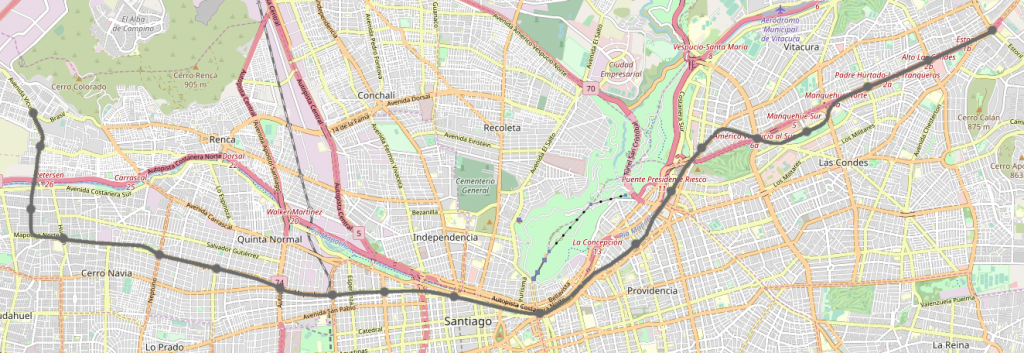
Line 7 is a $2.5 billion USD new rapid transit line currently under development for the Santiago Metro, with an expected opening in 2027. Designed primarily to alleviate congestion on the heavily used Line 1, Line 7 will run from Renca in the northwest of the city, pass through the central areas, and extend to the northeastern border of Las Condes and Vitacura. When completed in 2028, the line will feature 19 new stations and span 24.8 kilometers (15.4 miles). Its designated.
The route of Line 7 has a goal of reducing the passenger flow of Line 1 by an estimated 10,000 commuters daily. Transfers will be available with Lines 1, 2, 3, and 5, providing enhanced connectivity throughout the city. The line will directly serve the communities of Renca, Cerro Navia, Quinta Normal, Santiago, Providencia, Las Condes, and Vitacura, with Renca, Cerro Navia, and Vitacura gaining metro access for the first time. The project was first announced by President Michelle Bachelet during her June 1, 2017, speech.
Originally, Line 7 was planned to start at the intersection of Brazil Avenue and Vicuña Mackenna in Renca, moving south before crossing the Mapocho River near the Resbalón bridge in Cerro Navia. From there, it would follow Rolando Petersen south to Mapocho Avenue, then turn east through Cerro Navia and Quinta Normal. The line would intersect Lines 2 and 3 at Puente Cal y Canto, pass under the Mapocho river park corridor, and connect with Lines 1 and 5 at Baquedano. Continuing along Balmaceda Park and Andrés Bello Avenue, it would intersect Line 1 at Pedro de Valdivia, and then proceed along the southern boundary of Vitacura, ending at the junction of Presidente Kennedy Avenue with Estoril in Las Condes.
Construction began in 2022 and is utilizing both the Tunnel Boring Machine (TBM) method and the New Austrian Tunnelling Method (NATM), with an estimated inauguration in 2028. The project involves extensive underground work, including the excavation of 26 km of tunnels and the construction of six ventilation shafts.
Transport experts have proposed extending Line 7 to Santiago’s international airport, potentially rerouting through Pudahuel via San Daniel, Rio Itata, and Armando Cortínez Oriente avenues, passing the Enea business park. This modification would add 22 stations, incorporating new stops while eliminating three western stations from the original plan. Metro SA has not dismissed this proposal, and the Enea company has offered support.
In December 2017, a revised plan was published in El Mercurio, indicating that Line 7 would bypass Andrés Bello Avenue in favor of a route parallel to Line 1 along Providencia Avenue. The Salvador transfer was eliminated, with transfers relocated to Pedro de Valdivia, and the route continued under the original alignment at Isidora Goyenechea, connecting with Line 6. A section along Kennedy Avenue was also adjusted via Cerro Colorado. The official groundbreaking ceremony was conducted by President Sebastián Piñera on February 17, 2022.
According to the Ministry of Transport, commuters traveling from Renca to Vitacura are expected to save approximately one hour per trip, equating to roughly 21 days per year. The line will serve an estimated 322,979 residents within 600 meters (2,000 feet) of a station, covering 1,945 urban hectares. Beyond travel efficiency, Line 7 will enhance socio-economic and geographic integration, connecting historically underserved northwest Santiago with central and northeastern areas of the city.
There are a few challenges the project faced. The main challenge being the scale and complexity of the project. Because it is being built in busy metropolitan area with many historical and cultural centres, it must be integrated with existing infrastructure and consider other future transportation and infrastructure. It therefore needs supervision and management of other auxillary projects.
Some stations have to be built deeper than others to accomodate future lines. TBMs used must contend with water pressure from existing soil that tend to be saturated.
Residents pointed out the project’s environmental and social impact as well as noise complaints due to construction the location of a train yard.
- Subscribe to Our Newsletter: Stay updated with the latest insights, tips, and innovations in civil engineering.
- Check Out These Must-Read Resources:
- A comprehensive book on civil engineering to enhance your understanding of structural design and construction techniques.
- A captivating book about the lives of great civil engineers, showcasing the pioneers who shaped the modern world.
- A practical project inspection checklist—an essential tool for every engineer involved in site supervision and quality control.
- Dive into the genius of the Renaissance with our recommended book about Leonardo da Vinci, exploring his contributions to engineering and architecture.
- Don’t miss our field notebook and journal, designed specifically for civil engineers and architects to document projects, ideas, and on-site observations
No responses yet